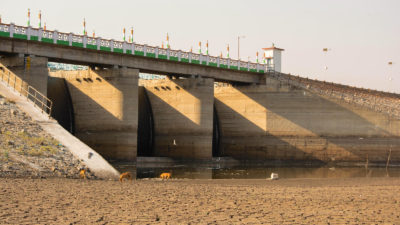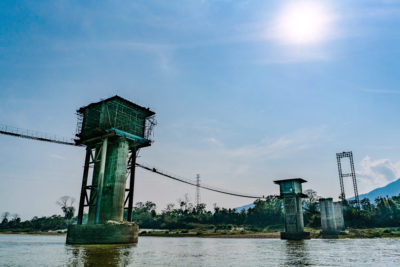The end of the big dam era is approaching.
Numerous recently published reports reflect this planet-altering fact. One study, conducted by scholars at the United Nations University’s Institute for Water, Environment and Health, found that construction of large dams globally fell from a late-1970s peak of about 1,500 a year to around 50 a year in 2020. “There will not be another ‘dam revolution’ to match the scale of the high-intensity dam construction experienced in the early to middle 20th century,” the 2021 study concluded.
Data compiled by the International Renewable Energy Agency (IRENA), an intergovernmental organization that promotes renewable energy, including hydropower, show that in the 21st century, newly installed hydropower capacity peaked in 2013 at 45,000 megawatts a year and then dropped every year but one through 2021, when it reached only 18,900 megawatts. Similarly, investments in new hydropower dropped from a peak of $26 billion in 2017 to an estimated $8 billion in 2022, according to IRENA.
Dam building in China declined sharply around 2015 and has stagnated ever since.
Four and a half years ago, Josh Klemm, now co-executive director at International Rivers, the globe’s most prominent dam-fighting NGO, declined to assert that the world had reached “peak dams,” the point at which the number of dams built annually levels off and begins to decline. But when contacted last month, he was far less cautious. A decline in dam building in the last few years in China, by far the world’s most prolific dam builder, “in and of itself could mean that ‘peak dams’ has arrived and we’re probably a few years into it,” he said. The shift is so pronounced that International Rivers, which has historically devoted 90 percent of its resources to fighting the construction of hydroelectric dams it considers particularly destructive, is now likely to focus more on supporting dam decommissioning and river protection, Klemm said.
Over the last century, hydropower provided energy for the construction of airplanes and tanks that enabled an Allied victory in World War II and generated as much as a fifth of the world’s electricity supply. By making irrigation possible, hydropower turned vast arid areas, including much of the western United States, into arenas of agricultural bounty.
But for the planet’s riverine life systems, the decrease in dam construction will lighten a heavy burden. Dams have stoppered nearly two-thirds of the globe’s major water systems, devastating their ecosystems. Dams and reservoirs have displaced millions of people, many of them members of Indigenous societies that were shattered by forced resettlement. And they have adversely affected the livelihoods of at least half a billion people who relied on plants and animals that no longer thrive. Reservoirs have shifted so much weight that geophysicists believe they have slightly altered the speed of the Earth’s rotation, the tilt of its axis, and the shape of its gravitational field. They have triggered thousands of earthquakes, sometimes with lethal consequences.
The Myitsone Dam project in Kachin State, Myanmar, was suspended in 2011 after protests. Quinn Ryan Mattingly for The Washington Post via Getty Images
According to a February 2023 IRENA report, the decline in construction of hydroelectric dams over the last decade has occurred in part because most favorable dam sites have already been taken and remaining sites are “usually located in less accessible locations, making construction significantly more expensive.” In addition, the report dryly acknowledged, new hydro plants “may encounter opposition from local populations and environmental groups.”
Throughout the 21st century, China has been the major force behind hydroelectric dam construction, both domestically and abroad. In fact, more than half of the world’s new hydropower capacity was installed within China during this period. But according to Eugene Simonov, coordinator of the Rivers Without Boundaries International Coalition and a researcher at the University of New South Wales, Canberra, dam building in China declined sharply around 2015 and has stagnated ever since.
“The most important trend in China is a radical reduction in the number of the dams constructed,” Simonov said. “Ninety percent of capacity added after 2020 is coming from just two megaprojects.”
Compared to other types of megaprojects, hydroelectric dams rank among the highest for cost overruns.
China appears to have lost enthusiasm for financing and building dams outside its borders, too, coincident with its decline in financing foreign development projects of all kinds — a response to the failure of many of its loans and negative publicity arising from controversial projects. Inclusive Development International, a nonprofit that tracks human rights violations and environmental damage caused by development projects, recently found that project financing by two of China’s policy banks, the China Development Bank and the Export-Import Bank of China, declined from 151 projects worth $87 billion in 2016 to only eight projects worth $3.7 billion in 2021.
The list of Chinese-supported dam projects that have attracted harsh criticism is long. It includes the $3.6-billion Chinese-backed Myitsone Dam, which would have caused widespread displacement, loss of livelihoods, major environmental damage, and destruction of cultural heritage sites in Myanmar’s Kachin state. Myanmar suspended the project in 2011 in response to protests, although China continued to press for its construction. And in northeastern Cambodia, the Lower Sesan 2 hydroelectric dam, completed by China in 2018, displaced almost 5,000 mostly Indigenous people, impaired the livelihoods of tens of thousands of others, and caused major losses in local fisheries.
China has also attempted to shield its involvement in controversial dam projects by using companies from other countries to act as intermediaries in construction. According to Simonov, the state-owned Power Construction Company of China hid behind Egyptian contractors to build Tanzania’s Julius Nyerere Power Station, which began filling last December. The much-criticized project will fragment, partially flood, and severely harm the Selous Game Reserve, a World Heritage Site, and impair flows to the Rufiji River Delta, which is ostensibly protected by the Ramsar Convention on Wetlands of International Importance.
Another reason for China’s growing disinterest in dams is economic competition from wind and solar energy. A study drawing on a database of more than 2,000 megaprojects compiled by Oxford University economic geographer Bent Flyvbjerg found that, of 25 types of projects that cost at least $1 billion, hydroelectric dams rank among the highest in cost overruns, while solar and wind projects rank lowest and third lowest, respectively.
Over the last decade, hydropower has suffered in comparison to solar and wind power both in terms of the cost of installation and the cost of electricity generated. A 2022 IRENA report found that the cost of hydropower installation rose 62 percent between 2010 and 2021, while over the same time period the cost of solar power installation dropped 82 percent; offshore wind dropped 41 percent; and onshore wind dropped 35 percent. In that decade, the costs of electricity from solar, offshore wind, and onshore wind declined by 88, 60, and 68 percent, respectively, while the cost of electricity from hydropower increased 24 percent.
According to the report, by 2021 the cost of electricity derived from hydropower and utility-scale solar power had reached parity, at 4.8 cents per kilowatt-hour, while onshore wind was already lower, at 3.3 cents per kilowatt-hour. As a result, global solar power growth in 2022 outpaced hydropower growth by 14 times, and wind growth surpassed hydropower by more than five times, according to IRENA statistics. All these trends are expected to continue.
Southern Africa’s Lake Kariba fell below 1 percent capacity in December, causing 19-hour blackouts.
While fewer new dams are being built, existing ones are aging: Most large dams in the U.S. were commissioned between the 1930s and the 1970s, and many now require extensive and expensive repair. The 2017 partial collapse of the spillway of the tallest dam in the U.S., the 770-foot-high Oroville Dam, in northern California, may suggest what’s in store if needed refurbishments are not carried out. The collapse triggered the evacuation of nearly 200,000 people and cost $1.1 billion to repair. The cost of rehabilitating the nation’s 4,000-plus federally owned dams, which are typically the largest ones, is $27.6 billion, according to the American Society of Civil Engineers. Current annual appropriations for dam repairs are orders of magnitude smaller than that.
As reservoirs age they collect sediment, and removing this material is usually too difficult and expensive to consider. The accumulating sediment deprives downstream channels of nutrients and substrate, and it displaces reservoir water, which reduces — or, given enough time, eliminates — a dam’s capacity to produce power. Another United Nations University study, published last December, reviewed estimated storage losses in more than 47,000 large dams and found that they had already lost 13 to 19 percent of their storage capacity. The study predicted the dams will lose another 10 percent of storage by 2050, and that the decrease “in all countries and regions will challenge many aspects of national economies, including irrigation, power generation, and water supply.”
The long-submerged village of Aceredo was revealed by a drought that sapped the Lindoso reservoir in Spain in February 2022. Emilio Morenatti / AP Photo
Climate change has made hydropower’s shortcomings even more glaring. As droughts have intensified, reservoir water levels have dropped, often to the point that grid operators ration or even curtail electricity consumption. Last year, Europe’s worst drought in at least 500 years caused steep declines in hydropower production, allowing solar power generation to surpass hydroelectric production for the first time. In Sichuan province, the combination last year of a heat wave and China’s worst drought in six decades forced factories to close for days at a time and shopping malls to reduce their hours.
Brazil’s recurring drought lowered reservoirs that serve São Paulo, the world’s fourth-largest city, to 5 percent of their capacity in 2014, and the metropolis came within days of running out of drinking water. Since then, Brazil has reconsidered its heavy reliance on hydropower and has turned increasingly to wind and solar. As a result of a long-running drought in southern Africa, Lake Kariba, the world’s largest reservoir — created by the construction of Kariba Dam on the Zambezi River in the late 1950s — fell below 1 percent of capacity last December, causing electricity blackouts that lasted 19 hours a day in Zimbabwe and six to 12 hours a day in Zambia, the two countries that share ownership of the dam.
The hydropower industry now casts dams as complements to wind and solar power.
In response to hydropower’s declining status, the International Hydropower Association (IHA) now casts hydroelectric dams as complements to wind and solar power, capable of generating electricity when skies are overcast and the wind isn’t blowing. The IHA has also placed new emphasis on pumped storage technology, which involves releasing water from an upstream reservoir through turbines when electricity demand and prices are high, collecting it in a downstream or off-river reservoir, and then pumping it back to the higher reservoir when electricity demand and prices are low.
If both reservoirs are located off-river and not blocking waterways — so-called “closed loop” pumped storage — the technology avoids much of the environmental damage that conventional hydro inflicts. Pumped storage systems typically consume more energy than they produce, but they are useful in balancing electricity loads in systems that rely on solar and wind power, and they generate revenue for dam owners.
The one region of the world that has bucked the trend of declining hydropower installations is Africa, where added annual hydro capacity has roughly stabilized in recent years. But even in Africa hydro’s prospects are dim, according to a modeling study presented at a meeting of the American Geophysical Union last December. “Within a decade or so, it’s very likely that solar and wind power will be more attractive investments than big hydropower,” said Sebastian Sterl, a study coauthor and an Africa-based researcher with the World Resources Institute. “The old refrain that hydropower is the cheapest source of electricity you can find will no longer be true.”




